Spring Data REST不完全指南(二)
东溪陈姓少年 人气:0上一篇文章介绍了Spring Data REST的功能及特征,以及演示了如何在项目中引入Spring Data REST并简单地启动演示了Spring Data REST项目。在本文中,我们将深入了解Spring Data REST的特性,以此来满足我们日常api开发工作的要求。
如果仅仅是上一篇文章中对Spring Data REST的使用,那无法做到在日常开发中使用Spring Data REST,所以在上一篇文章中,我们列出了日常api开发中的一些必要功能:
需要满足的一些要求:
1.针对字段级别,方法级别,类级别进行限制(禁止某些字段,方法,接口的对外映射)。
2.对数据增删改查的限制(禁止某些请求方法的访问)。
3.能个性化定义请求的路径。
4.对所传参数进行值校验。
5.响应统一处理。
6.异常处理。
7.数据处理的切面。
➡️本文,将演示这些要求中的前三个要求。
针对接口级别,方法级别,字段级别进行访问限制
所谓的访问限制,这里我们的目的是指定某些资源不对外暴露,Spring Data REST使用注解来实现各级别的访问限制。
接口级别的访问限制:
@RepositoryRestResource(exported = false)
public interface TenantRepository extends CrudRepository<Tenant, Long> {
Page<Tenant> findAllByNameContaining(String name, Pageable page);
Page<Tenant> findAllByIdCardContaining(String idCard, Pageable page);
Tenant findFirstByMobile(String mobile);
Tenant findFirstByIdCard(String idCard);
}
Spring Data REST中我们在接口级别增加@RepositoryRestResource(exported = false)来实现接口及接口中的所有方法不对外暴露,从而限制访问。
方法级别的访问限制:
public interface TenantRepository extends CrudRepository<Tenant, Long> {
Page<Tenant> findAllByNameContaining(String name, Pageable page);
Page<Tenant> findAllByIdCardContaining(String idCard, Pageable page);
Tenant findFirstByMobile(String mobile);
@RestResource(exported = false)
Tenant findFirstByIdCard(String idCard);
}
上述代码中,我们使用@RestResource(exported = false)注解在指定的方法上,从而实现该方法不对外暴露。
字段级别的访问限制
@Entity
@Data
@Accessors(chain = true)
public class Tenant {
@Id
@GeneratedValue
private Long id;
private String name;
//隐私信息不需要暴露
@JsonIgnore
private String idCard;
private String mobile;
@JsonFormat(pattern = "yyyy-MM-dd HH:mm:ss")
private LocalDateTime rentDateTime;
@OneToOne(cascade = CascadeType.ALL, orphanRemoval = true)
private House house;
public Tenant() {
}
public Tenant(String name, String idCard, String mobile, LocalDateTime rentDateTime, House hous) {
this.name = name;
this.idCard = idCard;
this.mobile = mobile;
this.rentDateTime = rentDateTime;
this.house = hous;
}
}
在上述代码中,我们在idCard字段上增加了@JsonIgnore注解,从而实现该字段不对外暴露。
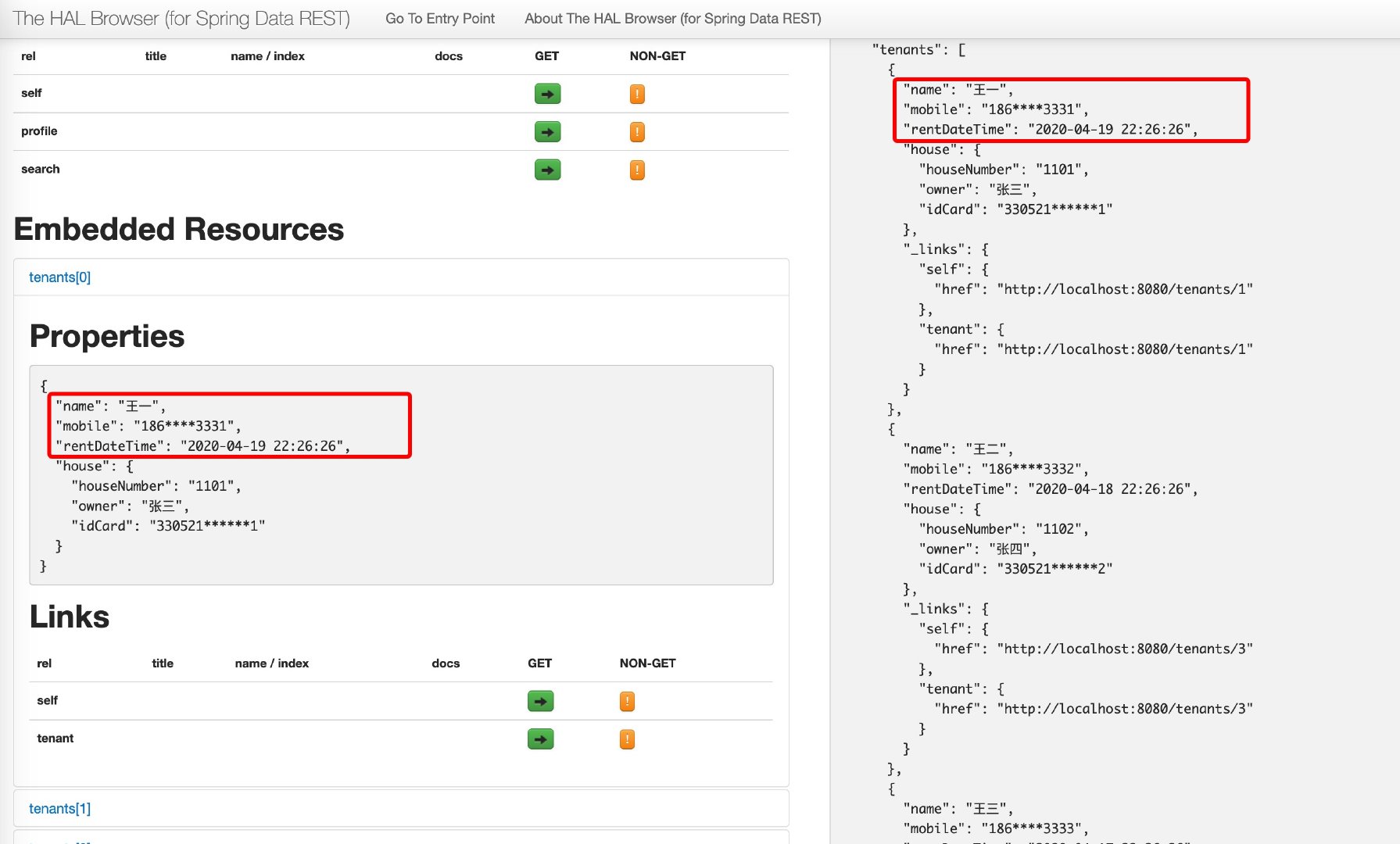
如上图,我们在HAL Browser中看到,输出的租客数据中不再包含idCard字段。
使用Projections和Excerpts来实现访问限制
@Projection(name = "mobileAndName", types = {Tenant.class})
public interface TenantProjection {
String getName();
String getMobile();
}
如上,首先我们声明一个投影(Projection),在上面的投影中,我们使用指定字段的get方法来对外暴露需要暴露的字段name,mobile。
此时,我们访问HAL Browser
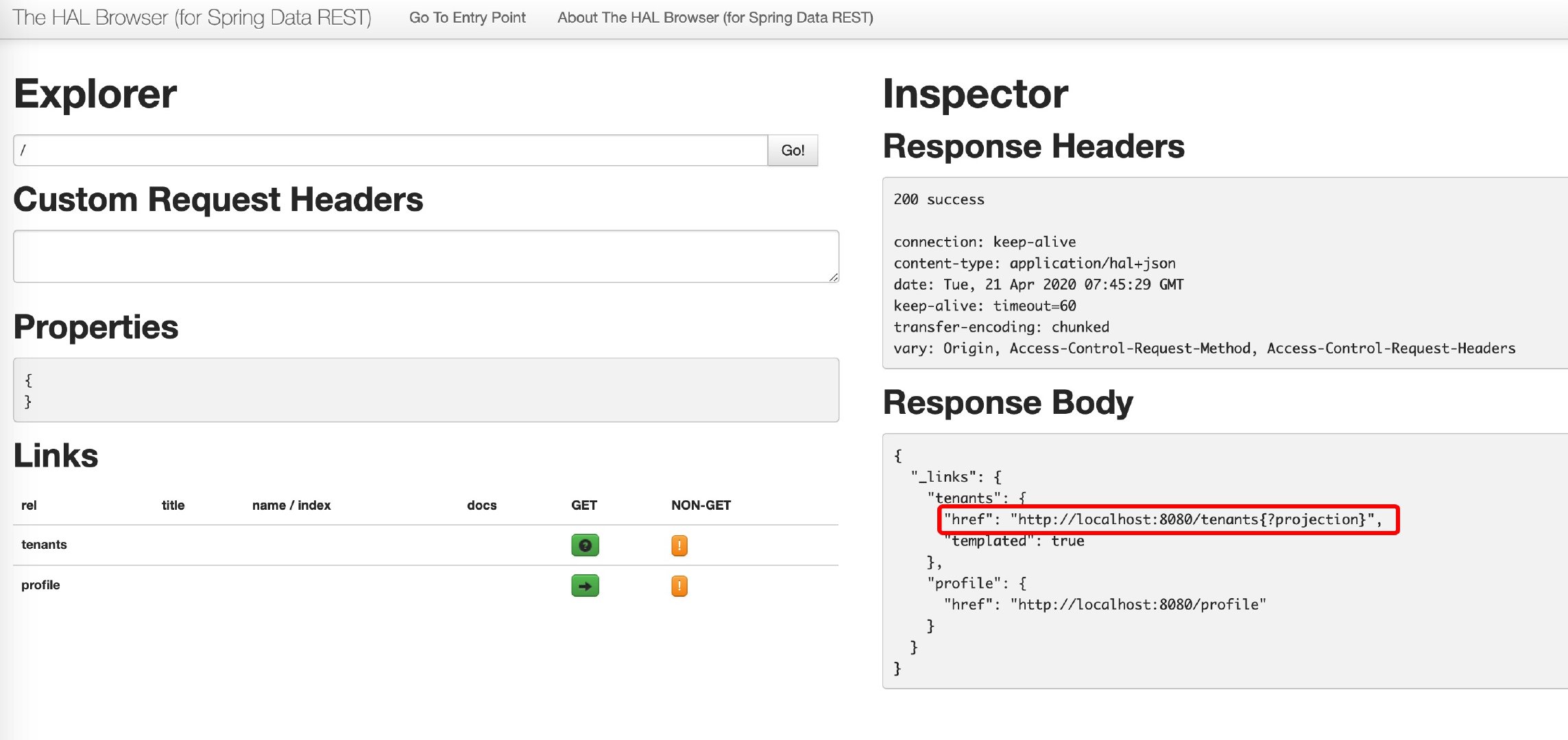
可以看到Spring Data REST此时提供了一个投影的链接。
此时我们查询指定租客类的投影http://localhost:8080/tenants/1?projection=mobileAndName
{
"name": "王一",
"mobile": "186****3331",
"_links": {
"self": {
"href": "http://localhost:8080/tenants/1"
},
"tenant": {
"href": "http://localhost:8080/tenants/1{?projection}",
"templated": true
}
}
}
可以看到只显示了我们投影的字段。
⚠️:我们声明的投影接口需要和数据类在同一个包中。
⚠️:否则,我们需要增加配置类,来告诉Spring Data REST投影接口的位置,如下图
@Component
public class SpringDataRestCustomization implements RepositoryRestConfigurer {
@Override
public void configureRepositoryRestConfiguration(RepositoryRestConfiguration config) {
config.getProjectionConfiguration().addProjection(TenantProjection.class);
}
数据内联
有时候,我们可能需要单独对House类进行数据操作,所以我们会声明一个HouseRepository
public interface HouseRepository extends CrudRepository<House, Long> {
}
此时,我们访问某一租客数据(http://localhost:8080/tenants/1)时,

此时,house的数据就不会内联在Tenant里面。但是我们并不想要这种效果,我们希望house还是内联在Tenant中的。我们可以使用Projection来解决此问题。
@Projection(name = "NameAndHouse", types = {Tenant.class})
public interface OnlyNameProjection {
String getName();
House getHouse();
}
如上,我们声明了一个NameAndHouse投影。然后我们使用@RepositoryRestResource(excerptProjection = OnlyNameProjection.class)注解放在TenantRepository接口上。
@RepositoryRestResource(excerptProjection = OnlyNameProjection.class)
public interface TenantRepository extends CrudRepository<Tenant, Long> {
...
}
此时,我们访问NameAndHouse投影(http://localhost:8080/tenants/1?projection=NameAndHouse)
{
"name": "王一",
"house": {
"houseNumber": "1101",
"owner": "张三",
"idCard": "330521******1"
},
"_links": {
"self": {
"href": "http://localhost:8080/tenants/1"
},
"tenant": {
"href": "http://localhost:8080/tenants/1{?projection}",
"templated": true
},
"house": {
"href": "http://localhost:8080/tenants/1/house"
}
}
}
可以看到,House已经被内联进Tenant中。
对数据增删改查的限制
Spring Data REST提供了对资源请求的限制,比如对特定请求方法的限制,对特定资源访问的限制。
Repository对外暴露限制
有时候我们希望,我们在Repository中定义的某些数据操作方法不对外暴露。Spring Data REST提供了了四个级别的资源限制级别:
- ALL:公开所有Spring Data存储库,无论其Java可见性或注释配置如何。
- DEFAULT:公开公共Spring数据存储库或使用
@RepositoryRestResource显式注释的存储库,并且其导出属性未设置为false。- VISIBILITY:无论注释配置如何,仅公开公共Spring Data存储库。
- ANNOTATED:仅公开使用
@RepositoryRestResource显式注释的Spring Data存储库,并且其导出属性未设置为false。
如下代码实现了ANNOTATED级别的限制:
@Component
public class SpringDataRestCustomization implements RepositoryRestConfigurer {
@Override
public void configureRepositoryRestConfiguration(RepositoryRestConfiguration config) { config.setRepositoryDetectionStrategy(RepositoryDetectionStrategy.RepositoryDetectionStrategies.ANNOTATED);
}
}
增删改查限制
在RESTful中定义:
GET(GET方法返回单个实体)
PUT(PUT方法用提供的请求主体替换目标资源的状态(存在则修改,不存在则新建)。)
PATCH(PATCH方法类似于PUT方法,但是部分更新资源状态。)
DELETE(删除信息)
所以所谓的对增删改查的限制实际上就是对请求方法的限制。
如下,我们对Tenant类进行了两个操作
- PUT操作禁止新增,但可以修改。
- DELETE限制,也就是限制了删除操作。
@Component
public class SpringDataRestCustomization implements RepositoryRestConfigurer {
@Override
public void configureRepositoryRestConfiguration(RepositoryRestConfiguration config) {
ExposureConfiguration exposureConfiguration = config.getExposureConfiguration();
exposureConfiguration.forDomainType(Tenant.class)
.disablePutForCreation()
.withItemExposure((metadata, httpMethods) -> httpMethods.disable(HttpMethod.DELETE));
}
}
如下为请求测试:
1.禁止DELETE请求

2.禁止PUT的新增操作
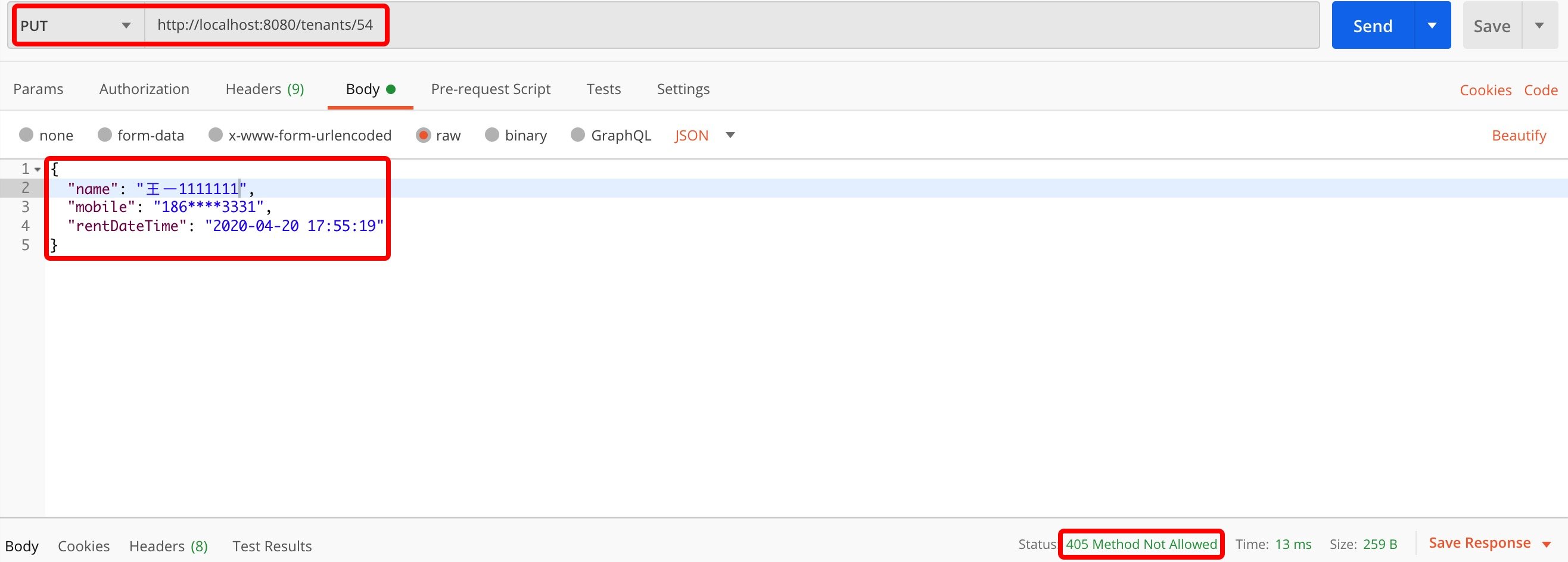
3.允许PUT的修改操作
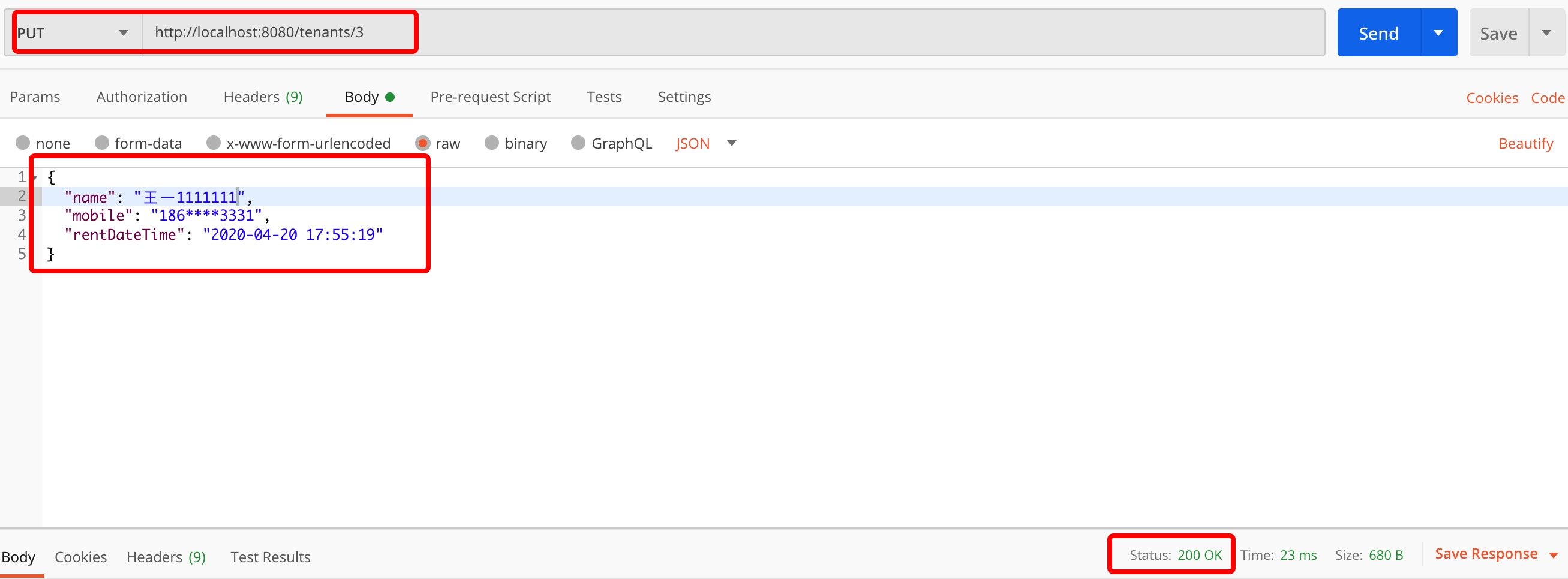
个性化定义请求的路径
Spring Data REST提供了个性化请求路径的功能
自定义项目资源URI
默认情况下,项目资源的URI包含用于集合资源的路径段,并附加了数据库标识符。这样一来,您就可以使用存储库的findOne(…)方法来查找实体实例。从Spring Data REST 2.5开始,可以通过使用RepositoryRestConfiguration上的配置API(在Java 8上首选)或通过将EntityLookup的实现注册为应用程序中的Spring bean来自定义此属性。 Spring Data REST会选择它们并根据其实现来调整URI生成。
@Component
public class SpringDataRestCustomization implements RepositoryRestConfigurer {
@Override
public void configureRepositoryRestConfiguration(RepositoryRestConfiguration config) {
config.withEntityLookup()
.forRepository(TenantRepository.class)
.withIdMapping(Tenant::getMobile)
.withLookup(TenantRepository::findFirstByMobile);
}
}
如上,我们个性化地指定了Tenant的标识符为mobile字段,此时我们可以通过HAL Browser来看到路径中的标识符变成了mobile字段。
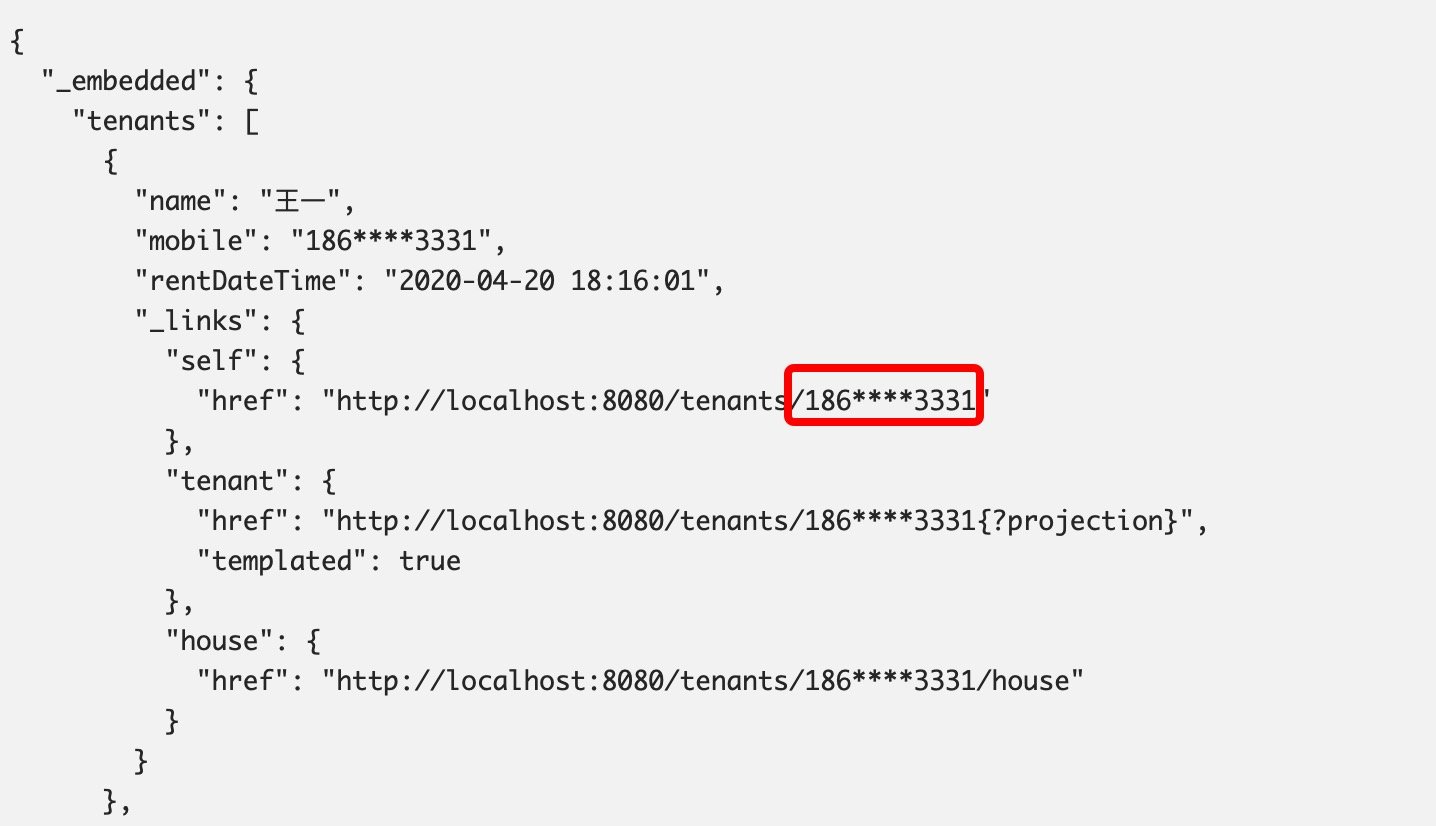
配置REST URL路径
我们使用@RepositoryRestResource和@RestResource注解直接指定资源在路径中的名字。
如下:
@RepositoryRestResource(path = "tenantPath")
public interface TenantRepository extends CrudRepository<Tenant, Long> {
@RestResource(path = "mobile")
Tenant findFirstByMobile(String mobile);
}
此时我们通过HAL Browser访问此资源:
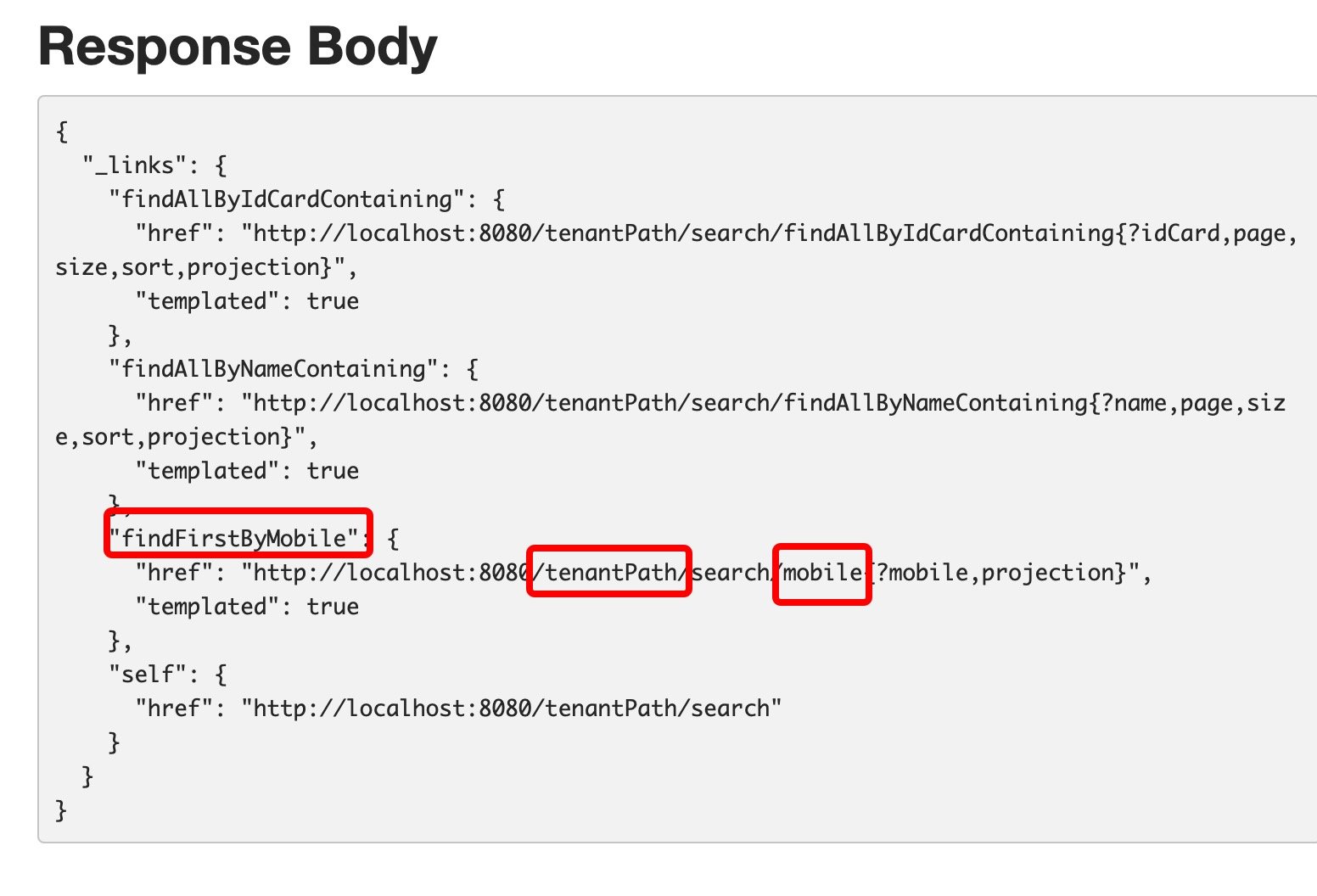
可以看到,被我们注解的findFirstByMobile对应的资源路径已经被定制化。
另外我们看到"links"中的属性名还是findFirstByMobile,我们可以通过@RestResource(path = "mobile",rel = "mobile")来个性化指定其名字,例如此注解中,我们指定了"links"中的findFirstByMobile属性名为mobile。

总结
本文列出了接口开发常用的7个功能,并且演示如何实现针对接口级别,方法级别,字段级别进行访问限制,我们使用@RepositoryRestResource,@RestResource,@JsonIgnore分别实现接口,方法,字段级别的访问限制,并且我们利用了Projections和Excerpts来实现自定义数据格式。我们还是实现了对数据增删改查的限制,我们通过RepositoryDetectionStrategy的四个级别来控制数据接口的对外暴露,使用ExposureConfiguration来限制某些资源对特定请求方式的限制。最后我们使用RepositoryRestConfiguration以及@RepositoryRestResource和@RestResource注解实现了个性化定义请求的路径。
本文代码示例:https://gitee.com/jeker8chen/spring-data-rest-in-practice.git
关注笔者公众号,推送各类原创/优质技术文章 ⬇️

加载全部内容